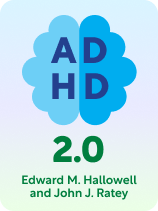
What’s the best way to introduce more structure into your life? What physical activities help relieve psychological symptoms?
Psychiatrists Edward Hallowell and John Ratey have good news: People with ADHD can adjust their lifestyles to minimize the downsides of ADHD and harness their own natural strengths. The authors recommend establishing structure, prioritizing health, and taking medication to relieve negative symptoms.
Keep reading to learn about three ADHD lifestyle changes that can contribute to a fulfilling life.
Lifestyle Change #1: Establish Structure
Halloway and Ratey say that structure and schedules help mitigate some of the problems that come with ADHD, especially time management and memory issues. However, people with ADHD tend to resist structure—structure is predictable, and predictability is boring.
(Shortform note: It’s common to feel trapped by structure and routine. For example, putting something into a calendar often makes it feel like something you have to do. Then, you get stuck going from one commitment to the next with no time for rest or spontaneity. Therefore, it may be helpful to remember that a calendar is just a tool, not a prison—it can’t control you or punish you. This is an especially helpful tip if you have ADHD, since people with that condition tend to resist any form of control, commitment, or structure.)
To make this ADHD lifestyle change, start small with structure by making daily to-do lists with just two tasks each. Writing those tasks down is a reminder that they’re important, and accomplishing the tasks will provide a quick hit of dopamine, which boosts motivation.
Once someone’s reliably accomplishing their two tasks each day, they can start adding more items to their daily lists and making more detailed schedules as they feel the urge to do so.
(Shortform note: This strategy takes advantage of what Mark Manson (The Subtle Art of Not Giving a F*ck) calls the motivation loop. Manson says many people misunderstand how motivation works—they think motivation has to come first, and it leads to action. However, in reality, motivation and action are a cycle: Motivation can lead to action, but taking action also creates more motivation to keep going. Therefore, by starting with some small action (such as making a to-do list with only two items), people can motivate themselves to keep improving their lives—for instance, by boosting their productivity by gradually adding more to-do list items.)
Lifestyle Change #2: Healthy Body, Healthy Brain
Hallowell and Ratey say that by taking proper care of their bodies, people with ADHD can mitigate many of their psychological symptoms. Two treatments for ADHD are good sleep habits and regular exercise.
Tip #1: Good Sleep Habits
Halloway and Ratey say that people with ADHD often struggle to get a good night’s sleep, and fatigue makes their symptoms much worse. That’s why it’s crucial for them to make sleep a priority.
(Shortform note: Many of the symptoms of sleep deprivation are almost identical to those of ADHD, which may explain why the two conditions compound each other. As neuroscientist Matthew Walker explains in Why We Sleep, sleep deprivation leads to inattentiveness, difficulty regulating your emotions, and memory loss.)
The authors suggest that people with ADHD set a firm time to be in bed with the lights out. They also give a couple of tips to maximize sleep quality: First, turn off any screens (phone, computer, TV, and so on) to avoid unnecessary stimulation. Second, make the bedroom as dark as possible; light tricks the brain into thinking it’s still daytime, which makes it much harder to get to sleep. Finally, if needed, use air conditioning or open a window to keep the room comfortably cool.
(Shortform note: Turning off screens and making the bedroom dark and cool can all be part of a regular bedtime routine. Having such a routine will get you into the habit of going to bed at the same time each night, as Hallowell and Ratey suggest. Other common practices that the authors don’t suggest here include taking a relaxing bath or shower, stretching to release muscle tension, practicing meditation or deep breathing exercises to quiet your mind, and reading a good book as a calming before-bed activity.)
The authors also recommend a shift in mindset. People with ADHD tend to suffer from the “fear of missing out” (FOMO), but they must recognize that good sleep habits will make them happier than whatever events they’re afraid of missing. This mental shift will help them get to bed on time, rather than staying up late in an attempt to be involved in everything.
| The Biology of Sleep Deprivation and Sleep Difficulties for People With ADHD Staying up late due to the fear of missing out on mood-boosting events may be counterproductive because of the negative effects sleep deprivation can have on mood. Some research suggests that sleep deprivation affects your mood because it makes your amygdala hyperactive. The amygdala is the part of your brain that controls your emotions, meaning you may become more emotional and more sensitive to stressful situations when you’re sleep deprived. Some people report that sleep deprivation not only strengthens their negative feelings like anger and sadness, but it also weakens their positive emotions like joy. Furthermore, sleep difficulties for people with ADHD aren’t always psychological, like FOMO is; they can be biological as well. If you have ADHD, your natural sleep cycle may start later than neurotypical people’s cycles. In other words, you don’t start feeling tired until later than most people do, and you don’t naturally wake up as early as other people. This can cause a lot of problems if you need to wake up early in the morning for school or work. This is also why darkening the room when you go to bed is so crucial—artificial light makes your brain think the sun is still up, which pushes back your natural sleep cycle even more. |
Tip #2: Regular Exercise
Hallowell and Ratey say that regular exercise is a natural way to boost dopamine and norepinephrine levels—the same effect that stimulant medications like Adderall achieve artificially. They recommend at least 20 minutes of exercise a day for maximum effect, but even just a few minutes of vigorous exercise can provide a quick boost to energy and focus.
(Shortform note: In addition to boosting dopamine (associated with motivation) and norepinephrine (associated with focus), regular exercise also boosts levels of serotonin, which is associated with happiness. Together, these three neurotransmitters are highly effective at easing ADHD symptoms. However, maximizing those benefits may take more exercise than the authors suggest—some other experts recommend 30 to 40 minutes of exercise, four to five times a week. There is research supporting the idea that brief bursts of intense exercise can boost concentration in the short term, but the effects last for about an hour at most, meaning that you’ll need to find opportunities to get up and move regularly throughout your day.)
Exercise can even help correct some of the structural differences in an ADHD brain. Remember that the cerebellum tends to be underdeveloped in people with ADHD, which inhibits their emotional control, focus, and coordination, among other things. The cerebellum is highly malleable thanks to a phenomenon called neuroplasticity: the brain’s ability to grow and repair itself. As a result, exercises that train balance and coordination can strengthen the cerebellum, which in turn will help mitigate some symptoms of ADHD.
For example, joining a sports team—which promotes focus and discipline as well as physical strength and coordination—could be an excellent choice for people with ADHD (as long as the sport is something they’re interested in).
(Shortform note: In Behave, neurologist Robert Sapolsky goes into more detail about neuroplasticity. He explains that the brain works like a muscle: The parts of it that get used most often grow bigger and stronger. Neuroplasticity also works in reverse, meaning the parts of the brain that don’t get used as much can become weaker. For people with ADHD, who are naturally impulsive and disinclined to focus on things that don’t interest them, this could mean that they’re making their own symptoms worse by strengthening the impulsive parts of their brains and weakening the thoughtful, rational parts.)
Finally, people with ADHD shouldn’t overlook the importance of exercising their brains. The authors suggest practicing mindfulness meditation, which trains people to observe their own thoughts without reacting to them. Mindfulness is extremely helpful for controlling impulses and quieting a racing mind.
| Impulsiveness Versus Mindfulness Mindfulness is the practice of acknowledging thoughts and sensations without judging them, thereby taking away their power to control your behavior. It means recognizing and identifying experiences but not thinking of them as “good” or “bad.” That, in turn, stops you from trying to chase after good experiences and avoid bad ones. In other words, mindfulness is the practice of acting thoughtfully instead of reacting impulsively. For example, suppose you start feeling hungry. If you’re an impulsive person, you’ll immediately think of this hunger as “bad” and stop whatever you’re doing to go get something to eat. On the other hand, if you practice mindfulness, you could acknowledge the feeling of hunger without thinking of it as something “bad” you must immediately get rid of by eating. You would first examine that feeling of hunger and determine whether your body really needs food or if something else (boredom, perhaps) is creating the urge to eat. Also, since mindfulness meditation involves choosing a single thing to focus all of your attention on, it naturally trains you to calm racing thoughts and quiet your mind. Doing so isn’t easy, especially for people with ADHD, so it may take a lot of practice before you can bring your thoughts under control. However, some ADHD experts say that meditation is a highly effective—even crucial—part of treatment. |
Lifestyle Change #3: Medication
According to the authors, medication is often helpful for controlling ADHD symptoms, especially in the short term. ADHD is commonly treated with stimulants like Adderall or Ritalin, which boost alertness and mood. These stimulant medications also help people with ADHD stay calm by reducing their impulsiveness.
(Shortform note: There has been some research into using caffeine—which is much more readily available than prescription stimulants—as a treatment for ADHD. The research shows that caffeine does have some benefits, especially for boosting attentiveness, and consuming it is significantly better than pursuing no treatment. However, other studies suggest that caffeine is significantly less effective than Ritalin at controlling hyperactivity and less effective than Adderall at controlling both hyperactivity and impulsiveness. Furthermore, it’s not advisable to combine caffeine with prescription stimulants, as that increases the risk of side effects like high blood pressure and insomnia.)
There’s a lot of social stigma around ADHD medication. Some people are afraid of addiction—either becoming addicts themselves or having a loved one get addicted to the medication. Others think that the pharmaceutical industry is running a scam to diagnose as many people as possible with ADHD and sell them drugs they don’t need. The authors counter that ADHD medication is proven to be safe and effective, and opposing the use of medication to improve people’s lives is ignorant and cruel.
| Addressing Concerns About Diagnosis and Treatment There may be some merit to people’s concerns about ADHD overdiagnosis. Some studies have suggested that ADHD is overdiagnosed—although, if true, this is the result of errors in diagnosis and not a pharmaceutical industry conspiracy. For example, multiple studies have shown that the youngest students in a class are more likely to be diagnosed with ADHD than their older classmates. This may be because their relative immaturity makes them seem to have ADHD symptoms like inattentiveness and hyperactivity when they’re actually developmentally normal for their age. Concerns about addiction may also be valid but are possibly overstated. Stimulant medications are known to be addictive when used incorrectly (such as taking too high a dose or using them too often). However, the risk of addiction is minimal so long as the patient has a prescription and takes their medicine only as directed. Some experts would say the authors downplay the side effects of prescription stimulants like Adderall, especially in young children. Such medicines can delay a child’s growth, cause insomnia, and raise their blood pressure, among other health risks. Ultimately, if you or your child are diagnosed with ADHD, discuss any concerns about medication with your psychiatrist. Then, you can work together to come up with a treatment plan that’s both effective and safe. |
Exercise: Make a Short To-Do List
Make a to-do list of two things that you’ll accomplish today (or tomorrow, if it’s already late). These might be work-related tasks, chores, or self-care projects like exercise and cooking a healthy dinner. (Recall that making short to-do lists a habit will create structure and motivation to help you accomplish whatever you need to get done each day.)

———End of Preview———
Like what you just read? Read the rest of the world's best book summary and analysis of John Ratey and Edward Hallowell's "ADHD 2.0" at Shortform.
Here's what you'll find in our full ADHD 2.0 summary:
- How people can thrive because of—not in spite of—having ADHD
- The biological causes of ADHD and its most prominent symptoms
- Ways to minimize ADHD's downsides and maximize the benefits






